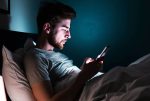Blue light keeps you awake by messing with your body clock and hormones. It is a type of visible light that comes from the sun, but also from artificial sources like LED and fluorescent lights, and many electronic devices. Blue light is not all bad.
Blue light can boost your brain and body during the day, syncing your circadian rhythms and preparing you for a restful night when the sun goes down.
In this article, we will show you how blue light keeps you awake and how to avoid its harmful effects.
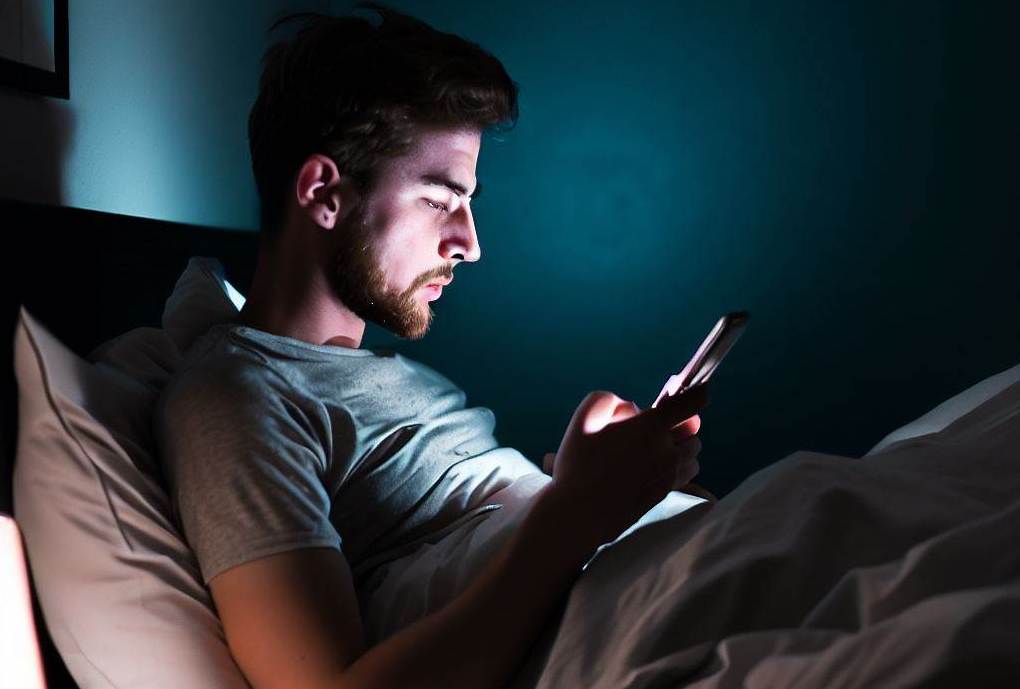
How and Why Blue Light Keeps You Awake
Blue light can be a friend or a foe for your sleep, depending on when you get it. It can help you overcome some sleep troubles with the right timing(1). But it can also ruin your sleep if you get too much of it before bed.
Blue Light and Melatonin
Blue light keeps you awake and messes up your sleep-wake cycle by inhibiting the production of melatonin, a hormone that signals our brain to feel sleepy and prepare for rest.
Research has found that blue light can affect our sleep in various ways, such as cutting down our sleep time by around 16 minutes and decreasing the amount of melatonin in our system. This can cause a disturbance in our natural circadian rhythm(2), which is vital for our physical and mental health.
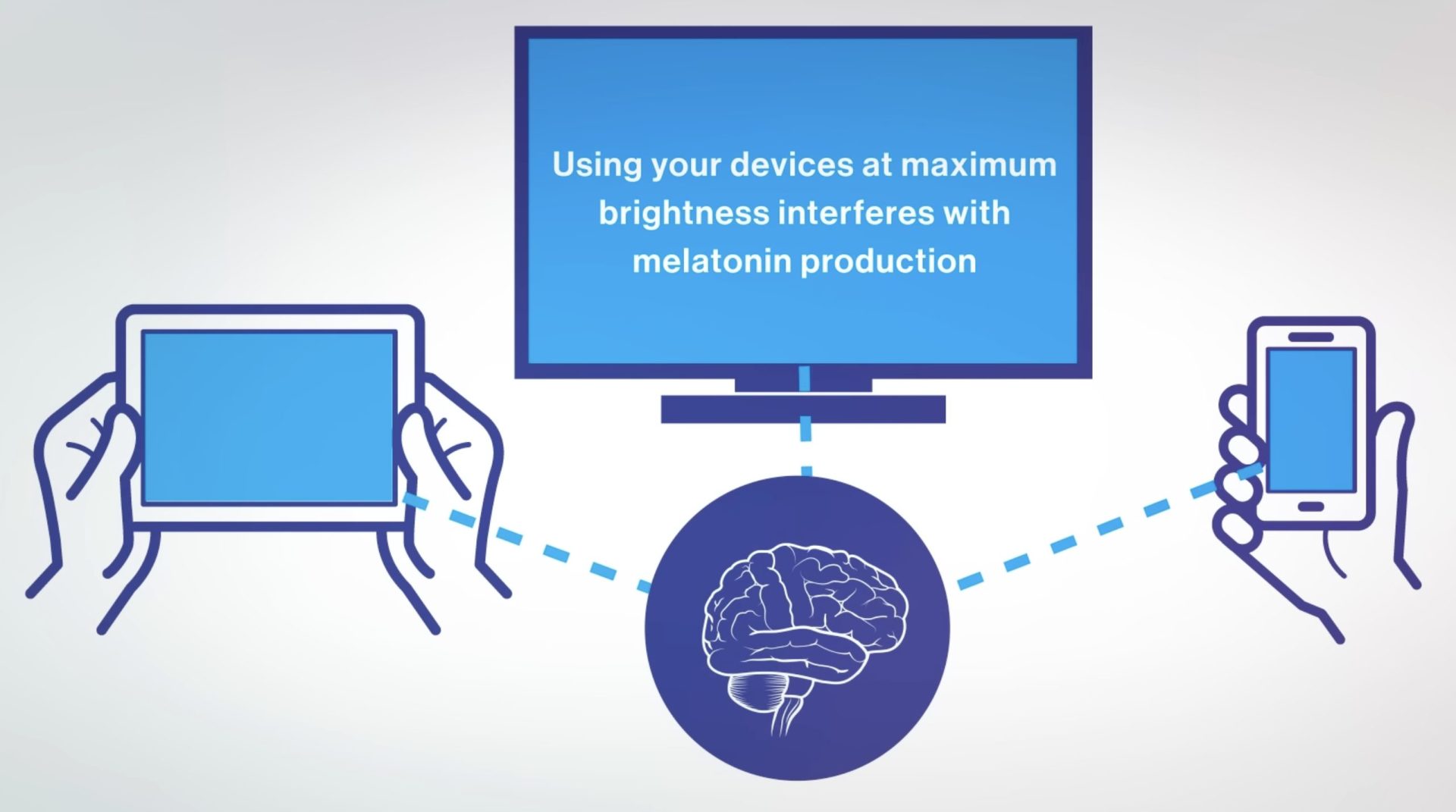
Blue Light and Circadian Rhythms
Our bodies follow a precise, 24-hour pattern called circadian rhythms(3), which regulate many vital functions, such as sleep. The main factor that influences our circadian rhythms is light, especially blue light, which has the strongest effect.
The sun is the main source of blue light for us, and it activates parts of our brain that keep us awake and alert, increasing our body temperature and heart rate. This can have positive effects on our performance and attention during the day, as well as help us adjust our circadian rhythms(4) and prepare for a good night’s sleep when it gets dark.
Some people who have trouble sleeping can benefit from carefully timed exposure to blue light as a form of treatment.
Blue Light and Sleep Quality
Blue light keeps you awake and disrupts your sleep quality by interfering with your body’s natural ability to wind down and relax before bedtime.
If you want to sleep better and feel more refreshed in the morning, it’s essential to reduce your exposure to light in the evening, especially blue light, which has the most powerful effect on your sleep-wake cycle.
Sources of Blue Light
Sunlight is the main source of blue light, but it is not the only one. Many other artificial sources of blue light surround us in our daily lives, such as fluorescent and incandescent light bulbs.
Moreover, with the increasing popularity of devices that use light-emitting diode (LED) technology, we are exposed to more blue light than ever before. Some of the common indoor sources of blue light are televisions, smartphones, tablets, gaming systems, fluorescent light bulbs, LED bulbs, and computer monitors.
A recent survey conducted in February 2021 revealed that almost half of the respondents spent an average of five to six hours on their phone every day. Another study by the Kaiser Family Foundation showed that children between 8 and 18 years old spend about 7.5 hours per day in front of a screen for entertainment purposes.
How To Prevent Blue Light From Keeping You Awake
If you want to reduce your exposure to artificial blue light, which can disrupt your sleep quality and quantity, there are several ways to do so. Here are some tips:
- Turn off your smartphone, TV, and other gadgets well before bedtime(5), as blue light keeps you awake by hindering your body’s ability to wind down and relax.
- Wear blue light-blocking glasses, which have amber or brown-tinted lenses that can filter out most of the blue light. You can find them online easily.
- Cut back on screen time starting 2-3 hours before bed. This will help your body prepare for sleep and avoid blue light stimulation.
- Dim the brightness on your devices or use night mode/dark mode, which changes the background color from white to black. This will reduce the amount of blue light emitted by your screens.
- Download blue light-filtering apps on smartphone, tablet, and computer screens. These apps can block a lot of blue light from reaching your eyes without affecting the visibility of the display.
- Swap light bulbs for ones that emit less blue light. LEDs and fluorescent bulbs emit more blue light than incandescent bulbs, which are being phased out. Choose warmer colors for your lighting.
- Use a dim red lightbulb as a nightlight. Red is the color that least affects your circadian rhythm and does not interfere with your sleep quality.
- Take regular breaks from computer or TV screens to rest your eyes and limit blue light exposure. Every 20 minutes, look away from your screen and focus on an object 20 feet away for at least 20 seconds. This will prevent eye strain and fatigue.
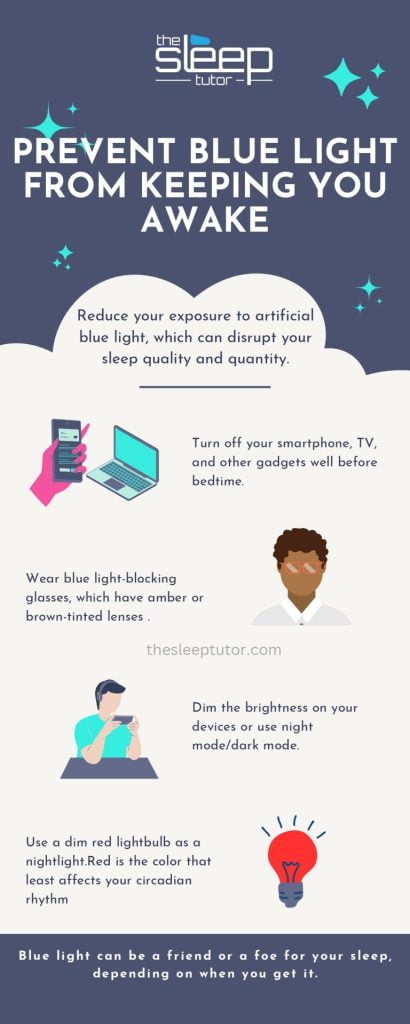
To sum up, blue light keeps you awake by interfering with the production of melatonin, a hormone that signals your brain to feel sleepy. Exposure to blue light in the evening can disrupt your sleep quality and quantity, as it prevents your body from winding down and relaxing. Reducing your exposure to light in the evening, especially blue light, is a key way to help your body naturally prepare for sleep and get quality rest.
There are several ways to do this. You can turn off your electronic devices well before bedtime, wear blue light-blocking glasses, limit your screen time starting 2-3 hours before bed, adjust the brightness on your devices or switch to night mode/dark mode, download blue light-filtering apps on your devices, swap light bulbs for ones that emit less blue light, use a dim red lightbulb as a nightlight, and take regular breaks from screens.
References
- Joshua J Gooley – “Treatment of circadian rhythm sleep disorders with light” Ann Acad Med Singapore, 2008 Aug; 37(8):669-76. https://pubmed.ncbi.nlm.nih.gov/18797560/
- Siegfried Wahl , Moritz Engelhardt, Patrick Schaupp, Christian Lappe, Iliya V Ivanov – “The inner clock-Blue light sets the human rhythm” J Biophotonics 2019 Dec 12(12), e201900102. https://pubmed.ncbi.nlm.nih.gov/31433569/
- Sollars, P. J., & Pickard, G. E. (2015) – “The Neurobiology of Circadian Rhythms.” The Psychiatric clinics of North America, 38(4), 645–665. https://pubmed.ncbi.nlm.nih.gov/26600101/
- Steven W. Lockley, George C. Brainard, Charles A. Czeisler – “High Sensitivity of the Human Circadian Melatonin Rhythm to Resetting by Short Wavelength Light” The Journal of Clinical Endocrinology & Metabolism, Volume 88, Issue 9, 1 September 2003, Pages 4502–4505 https://academic.oup.com/jcem/article/88/9/4502/2845835
- Ari Shechter, Elijah Wookhyun Kim, Marie-Pierre St-Onge, Andrew J Westwood – “Blocking nocturnal blue light for insomnia: A randomized controlled trial” A randomized controlled trial. Journal of Psychiatric Research, 96, 196–202. https://pubmed.ncbi.nlm.nih.gov/29101797/

